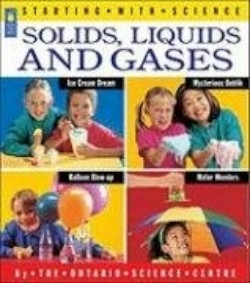Solids, Liquids and Gases (Starting with Science)
In a recent article in the Detroit News, students in a Royal Oak, Michigan, elementary school are featured learning about science through a new curriculum, which stresses hands-on experimentation. Student response has been extremely positive, which should come as no great surprise. Listen to a lecture about simple machines or build a milk-carton paddle wheel boat that can plow through water to learn about wedges and wheels… No contest.
This trend toward active involvement in science has seen a resurgence in the past few years, with one noticeable change. The emphasis now is on hands-on science for younger and younger students. Across the country, school districts are re-writing curricula, placing more importance on the idea that students learn science best when they are actively involved. Until now, there haven’t been many good books of experiments for young children that deal with basic scientific principles and include projects that are not only fun, but easy to understand and replicate. Kids Can Press, a Canadian based company, has answered the call by teaming up with the Ontario Science Centre to produce four books in a series called Starting With Science. Although the age recommendation is five to nine, many of the experiments would be appealing to older children as well. The four areas of science covered are: Solids, Liquids and Gases; Simple Machines; Living Things; and Plants. Each title includes thirteen science experiments, an index, glossary and a page of parent and teacher information with discussion questions and ideas for extending the activities.
The directions for each experiment are simple to follow and the results (explained in a side box called “What’s Happening?”) are clearly described. Children should have no trouble collecting the needed materials from home, and the experiments are almost all designed for them to work together. The activities are especially appealing because of their variety and originality. Titles such as “Summer Frost,” “The Eating Game” and “Hairy Egg Heads” will attract young scientists and educators alike. Children can try anything from starting a worm farm to building a pulley or creating mysterious ooblik. Many of the projects involve elements of surprise, allowing children to discover how to blow up a balloon without blowing, or hold a glass of water upside down without any spilling. While this style of exploration can be found in some of the Vickie Cobb experiment books, such as Bet You Can’t (Lothrop, 1980) the Starting With Science series is more visually attractive and more accessible to a younger audience.
In addition to the excellent collection of activities, the design and presentation of these books is worth noting. Boudreau’s double page photographs in eye-catching primary colors are brilliant and cheerful. Text and photos are well balanced, with nothing extraneous on any page. The children doing the experiments look like they are having fun! There is plenty of ethnic and gender diversity among the models, who are all wearing plain, brightly colored tops and jeans, which means this series will not be “out of fashion” any time soon.
For a classroom, a child’s party or simply a curious budding scientist, Starting with Science is a series that will provide just the needed direction for hours of enjoyable learning.
Reviewed by
Leigh Forrest
Disclosure: This article is not an endorsement, but a review. The publisher of this book provided free copies of the book to have their book reviewed by a professional reviewer. No fee was paid by the publisher for this review. Foreword Reviews only recommends books that we love. Foreword Magazine, Inc. is disclosing this in accordance with the Federal Trade Commission’s 16 CFR, Part 255.

